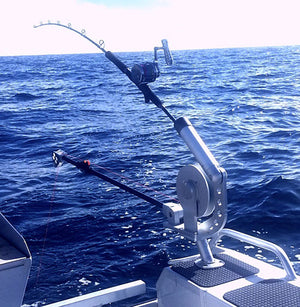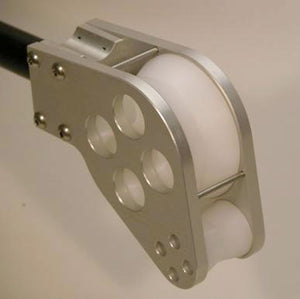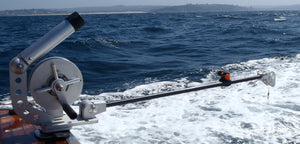Downrigger
$650.00
| /
- Ready to go out of the box
- The downrigger is heavily anodised
- Includes a 4 pound weight, release clip and depth counter
- Swivel boomhead for turning
- Carbontex drag washers
- 65 meters of 200 pound braid
- Tilting boom arm with locking mechanism
- Adjustable rod holder
- Solid aluminium tube rod holder
Collections: All products, Downriggers, Downriggers and Accessories
Category: Downrigger
Type: Downrigger
Many years ago I was fishing for barramundi on Bathurst Island, in the Northern Territory. My guide for the week, Brett, didn’t have much formal education, but was wise to the ways of fish. He had been brought up on a mackerel boat based in Wyndham, and had packed thousands of hours of fishing into his young life. Each morning, Brett and I would leave before dawn to fish for Spanish mackerel around the rocky headlands. The mackerel came on the bite at first light, and disappeared about an hour after sunup. One day, I asked Brett why these big predators were so predictable with their main hunting period.
Brett opened his tackle box and picked up a long minnow lure to explain. ‘Andy, all bait fish, no matter what type, have something in common: a dark back, blue, black or green. And a light coloured underside- silver, white, or cream. The sea birds that hunt them from the air look down from above, and find it hard to distinguish the dark backs from the dark coloured water. The big fish that hunt them from below look up and find it hard to distinguish their silver bellies from the bright light above.

It’s only at dawn and dusk, when the sun is at an acute angle to the water, that light reflects off the side of the bait fish, making hunting them easier. And dawn is usually better than dusk because the seas are calmer, early in the morning.’
Those weren’t his exact words, but Brett’s insights were spot on. When the early morning feeding opportunity has passed, mackerel take up station over deep reefs. Yellowtail kingfish, which occupy the Spanish mackerel’s place in the food chain around the southern half of Australia, do the same thing. During the middle of the day they’re the same aggressive predators, but like all predators conserve energy, when not hunting. Yet if a bait or lure is placed deeper in the water, close to where the fish are on station, a strike will usually result.
This is where downriggers come in. By using a downrigger, in combination with a depth sounder, you can present your bait or lure to fish marking on your screen, or at the depth where fish are likely to be holding.

In waters adjoining major metropolitan centres, or popular fishing spots, predators will tend to hold deeper and get on station earlier, because they don’t like boat traffic. This is why fishing in Sydney Harbour or Port Phillip Bay is often better midweek, than on weekends. With downriggers you can still produce fish in the middle of the day, in Australia’s busiest waterways. This technique is particularly deadly on trout, kingfish, Spanish mackerel, and marlin.

Downriggers come in all shapes and sizes. The technique was first popularised in the USA, originally used to target salmon and large trout in the Great Lakes. I went on a downrigging charter on Lake Michigan, near to the Illinois / Wisconsin border. That kind of fishing is radically different to Australian conditions. With cheap fuel, much larger boats are used. We fished from a 40 foot express, which had a transom at least twelve feet across. The boat had no marlin board, no motor legs and a shaft drive, allowing the use of multiple downriggers. The Great Lakes are freshwater, so downrigger corrosion is not a concern. And through summer, the Lakes are very calm. Check the pic below, the lake was flat as this all week:

So very different, to Australian conditions. Here, the average boat is 5 or 6 metres long. The combination of strong sunlight and salt water makes corrosion a serious concern. Our seas are often rough, meaning a robust downrigger is needed. Most boats are powered by outboards, meaning a long downrigger boom is required to keep gear away from the propeller. That’s why our downrigger is built for the toughest Australian conditions, whether just offshore chasing kingfish;

Or on the continental shelf, fishing for marlin. Two marlin caught this day on the downrigger, a blue and a striped:

Or on the continental shelf, fishing for marlin. Two marlin caught this day on the downrigger, a blue and a striped:
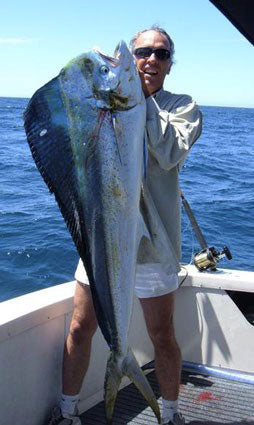
The idea of our downrigger is that it’s supplied complete straight out of the box.

You don’t need to visit the tackle store for weights, release clips, bases and expensive accessories. Firstly, it features a one metre boom to keep everything clear of the prop, even when you’re making tight turns;

Components are heavily anodised, to protect against corrosion;

The downrigger is fitted with a swivel boomhead, which rotates on needle bearings. This swivels towards the downrigger weight on hard boat turns, meaning you can do a 180 and go back over good marks, on the sounder;

A detachable resettable depth counter is also enclosed. It measures in metres;

Our downrigger is fitted with tough Carbontex drag washers, the same kind used in premium game reels;

the downrigger is supplied with a 4-pound lead weight:

Our downrigger is pre-spooled with 65 metres of 200-pound braid:

We prefer braid to nylon-coated steel cable, for several reasons:
Ours has a locking/tilting boom arm, which locks in both up and down position with a pin:

making the downrigger easy to store in the boat rod rack;

It has an adjustable rod holder, so you don’t lose a rod holder when mounting your downrigger. . Here’s the procedure. Take rod holder tube in left hand, grasp rod holder mount in right hand:

Pull base of tube away from mount, using left hand:

Rotate tube to preferred angle and release pressure so that detent pin locks in:

And you’re set to go. The downrigger is supplied with a solid aluminium tube rod holder gimbal. This will fit perfectly in every 37 degree (the industry standard) rod holder and will lock in place on the cross pin:

If you want your downrigger to point to starboard or port simply undo the four screws holding it to the piece above, rotate 90 degrees, and re tighten the screws. That works fine:

The second mounting option is a three piece detachable sliding base (sold separately). With this system, one plate is mounted on the transom of your boat, another up the front or in the cabin where your downrigger will be stored. The third grooved piece is bolted to the bottom of your downrigger. A locking pin is fitted to ensure secure storage or use.

One Du-Bro downrigger release clip is included;

Everything you need to start is included in our downrigger package.
There’s no need to go to the tackle shop for bits and pieces, it’s all ready to go.
Eleven minutes, twelve videos, dealing with every aspect of downrigging. If you’ve got time to check them out go for it, because owning a downrigger will shake up your fishing in the best possible way:
First up, here’s downrigger mounting options for your boat (70 seconds)
How to adjust rod holder on your downrigger (25 seconds)
Next, the most humane way to attach livebait to your hook (90 seconds)
How to put your line in the downrigger release clip (145 seconds)
Attaching your line using rubber bands - works really well (110 seconds)
When kingfish attack – downrigger cam video (64 seconds)
When mackerel attack – downrigger cam video (16 seconds)
First downrigged kingfish (14 seconds)
Double hookup on two downriggers (9 seconds)
Big fish hooks up – using the techniques shown above (24 seconds)
Big fish boated (28 seconds)
Maintaining your downrigger drag system – it’s easy (82 seconds)
Firstly, check out this video, How To Set Up Your Downrigger:
Once you’ve assembled everything as shown in the video above you’re ready to go. Here’s a suggested how to for your first trip:
Select a spot where your target species are known to be, or likely to be. In most cases that will be a spot holding bait fish, which in turn attracts apex predators;

Live squid a deadly bait for kingfish, check our how-to pages on the best way to rig them:

Live bait excellent for all predators. Bridling with a rubber band the best way to rig them to stay fresh. If not familiar with that method, check our how-to pages:

Put the boat in gear, slowest speed, just off neutral. Boat should be going straight, downwind usually the best;
Attach your boat and lure and run it back behind the prop. Check to make sure that your lure or bait is swimming correctly;
Drop the rod in the rod holder and grasp the line at the rod tip. Back off the drag so you’ve got something to work with;
Owners ask me what distance should the bait be, behind the weight. In most cases, and certainly when fishing for kingfish in shallow water, I like mine up close, usually two metres behind. Three main reasons:
The fish don’t care. They are not alarmed by the weight. Actually, it’s possible they are attracted by it;
If you have your bait or lure way back and need to make a turn with the boat it will come around on an acute angler and may even go near the prop. Keeping your bait up close to the weight means that, with the long arm on our downrigger, you can turn your boat like a car and still keep everything clear. For instance, you might see a missed strike on the rod tip, signs that the bait fish is alarmed, or mark a good show on your sounder screen that you wish to revisit. If the bait is up close you can do a hard turn and go back over;
Why give a hooked fish a head start? Every metre of line between the rod tip and the hook puts him that much closer, to the reef.
Your bait is now attached to either the downrigger release clip or the rubber band and is swimming comfortably behind the boat. You are ready to set depth. Firstly, back off the drag on your reel, so that as the weight sinks it won’t tear your fishing line out of the release. Hit the orange button on your line counter, so it resets to zero. The boat should be going slow ahead. Note that, at speeds over three knots, small live bait will start to spin. So if the current is fast and everything’s streaming nicely behind your downrigger, there’s nothing wrong in drifting with the boat in neutral. Palm the downrigger spool with your left hand (to prevent an over run) and, with your right hand, turn the spool tensioner anti clockwise. Your weight will sink, taking the bait with it;
Watching the line counter, stop the downrigger spool with your left hand when the preferred depth is reached. Tighten the spool tensioner with your right hand and you’re under way. Often you’ll be able to see the weight on your sounder screen and observe its position relative to passing fish. In this case, the weight is at nine metres, in eighteen metres of water:

Hugging the bottom contours is a risky business because your downrigger weight could foul the bottom on a sudden jump up. And in most cases, it’s not necessary anyway. For general downrigging over a rough bottom I usually set depth half way down. Kingfish are very aggressive predators and have no problem at all rising in the water column to attack a bait moving overhead. If you are downrigging over a sand bottom, or somewhere with no obstructions, you can go as deep as you like.
Three things to mention in closing. Firstly, if you are reading this from outside Australia, and assuming the downrigger would cost too much to import, don’t. In this country we have no sales tax on exports, meaning a $50 deduction straight off the top. And often, airmail isn’t as much as you think – seamail even cheaper. So send me an email with your location, for a quote? You might be pleasantly surprised.
Secondly, a lot of anglers contact me concerned our downrigger might not be an easy install, on their boat. Don’t be concerned. We have fitted downriggers to almost every kind of boat imaginable. Some examples below. We can supply longer booms, different mounting setups and of course the boom arm can be rotated, to operate out to one side of your boat. For any questions at all, just send me an email? I will respond promptly.
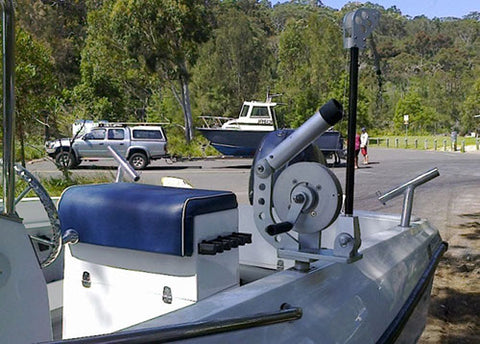



The bottom line is, we’ve worked hard to produce the best downrigger on the market. And even though we’re still improving it with every production we reckon we’ve achieved that. But don’t take my word for it. Check out these reviews from happy owners:
Andrew , I went out for a solo trip off Noosa last weekend here are pics of my day out – it rained a lot onshore all weekend but nothing much offshore, just passing squalls. Got one hoo, three stripies and bag limit of pearlies (returning the pearlies due to the green fishing ban ?)


I use the manual downrigger with 3lb weight for up to 5m down and the electric downrigger with 10lb weight for deeper – set up works well with rigged garfish.

Headed across the bay in reasonable weather and then out through the south passage bar. Never crossed the bar on the southern end, but had seen a few boats do it before. Dodged a few sharp waves that got the heart pumping, though made it out the other side. Over to the bait reef for a load of livies which took a little while, though managed a dozen or so. It was about 6:30am by the time we had a bait in the water, as it is a 50km run from Manly to the fishing grounds. We had one bait on the downrigger, and one on the surface and within 3 minutes we had a double hook-up and all hell broke loose.

We managed to keep the fish away from each other and also get the downrigger up before they tangled with it. We landed both fish and got 2 more baits in the water. Again the baits were in the water for another five minutes and the downrigger goes off again. Another cracking spanish mack. We ended up with 5 fish for the morning and 3 from the downrigger.

Still excited about the haul the previous day, and a mate in town keen to head out, off we went again. Water colour was completely different with a green tinge to it, and the fish proved bloody hard to get. We landed a shark mackerel first, then two nice yellowfin tuna all on the downrigger. Things went really quiet for the next 2 hours and no one around us was catching anything. We ventured out into the deeper water and dropped the rigger really deep. In almost 40 meters of water, the line on the downrigger starts screaming and finally we got a blue for the morning.

Grant Rand fished South West Rocks, with two of our downriggers he’s customised:
We went out and crossed the bar straight out to get livies. It was a struggle to get any after an hour and a half we had enough for the day trolled around the gaol for a few hours with nothing happening. We packed up and headed for fish rock, started to troll x-raps about 250m before, and on our first pass we had a double hook up on yellowfin. Lost 1 mid fight, and I lost mine right at the back of the boat it was a good fin around the 20KG mark disappointing but very promising. Next pass we boated a nice mack tuna and for the next 2 hours it was mack after mack. After pulling in a mack I put the x-rap back out, and got smashed straight away by a small yellow fin of 7KG. On our last pass Liams rod goes nuts, 10 mins later we had a 115 cm spaniard on board. Not a bad day for our first day fishing at SWR 15 or so fish in the boat and a good feed of fish for the night. Most of the fish were caught on your braid so a thumbs up on testing it out.

Fred Burley bought a downrigger from us, and headed to Jervis Bay with his Quintrex in tow:

Saw water as warm as 24.2 degrees last week 100m off Currarong last week and my brother in law picked up a Yellowfin Tuna trolling. (another first). We have been consistently catching Bonito and Rat Kingfish on trolled lures and downrigging yakkas up and down the Beecroft peninsula. Great fun!!

Thursday though at the Drumsticks was insane. Amongst non stop action with Rats averaging 60cm, at 3.00pm picked up 130cm/18kg Kingie in 30m of water. I was only on 10-15kg rod and 50 pound braid. What an experience!! My brother in law picked up one at 100cm on Saturday too.

Downrigging has really put a smile on my face!!

Beautiful. Downrigging’s deadly for big mahi. Tony won at the Whitsundays comp with a 17 kilo one. He writes:
The Mahi was caught on the eastern side of Hook Island & the reef, about 60km off the mainland. We won the heaviest other game fish & runner up highest combined point score.

Brad writes from WA:

I share a boat with a Friend Paul Grant who put me onto your site and he purchased a Down rigger and each got some Braid. Paul asked me to send some photos of a recent trip which we got the equipment for.
It was the 1st time we had used a Downrigger so was all new to us but found it very effective when we only raised 1 Marlin for the trip but interestingly it was caught on the Downrigger in preference to the other 3 surface rigs we had out…. he was released and we hope to catch up with him again next year.
Chris, in Sydney:

Hi Andrew, had some success off Wattamolla on the kingies yesterday. After getting dusted 4 times the week before on both 80lb braid and 24kg mono, I invested in a Stella 20000, spooled it with 150lb braid and had another crack. Caught these 2 fish in less than 15m of water in close to the cliffs, using yr downrigger with live yakkas.
If you have any questions whatsoever on downriggers, please call or email. And if you would like a free DVD on downrigging by mail, just click the contact tab on the front webpage? Thanks for reading,
Andrew Hestelow
Managing Director
You may also like
Sign up to get the latest fishing reports, how to's and tackle news
© 2025 Downriggershop.
Powered by Shopify




